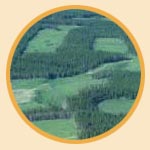Harvesting
 In Alberta,
areas designated for harvest are usually cut in two stages, or
"passes." In the first pass, one half of the merchantable timber is
logged using a patchwork pattern designed to fit into the landscape. The pattern
alternates between harvested patches ("cutblocks"), and unharvested
patches ("leave blocks") of similar size. The leave blocks are
harvested in the second stage, 10 to 20 years later when the cutblocks harvested
in the first pass are growing well again as new forests. In Alberta,
areas designated for harvest are usually cut in two stages, or
"passes." In the first pass, one half of the merchantable timber is
logged using a patchwork pattern designed to fit into the landscape. The pattern
alternates between harvested patches ("cutblocks"), and unharvested
patches ("leave blocks") of similar size. The leave blocks are
harvested in the second stage, 10 to 20 years later when the cutblocks harvested
in the first pass are growing well again as new forests.
The seedlings of
some tree species (for example, lodgepole pine and aspen) have adapted to open
conditions. They regenerate and grow well in the soil and sunlight conditions of
cleared areas (similar to the conditions created by forest fires). For this
reason, the two-pass system tends to be the most economical and appropriate
technique for harvesting these types of forests. Harvesting must be done
properly, in accordance with provincial legislation and policy, in order to
protect sensitive watersheds and the ecosystems of rivers.
The size of
cutblocks varies, but maximum average sizes are given as guidelines by the
Alberta government. For spruce trees, maximum cutblock size may vary from 24
hectares to 32 hectares depending on the type of block. For pine and deciduous trees, cut blocks may average 60 hectares and individual blocks may be as large
as 100 hectares. Average cutblock size in Alberta over the last three decades
has varied from 10.9 to 24.2 hectares for coniferous species, and from 13.2 to
46.0 hectares for deciduous species.
Department of the Environment. State of the Environment Report, Terrestrial Ecosystems. Edmonton: n.p., 2001. With permission from Alberta Environment.
  |
|
 Heritage Community Foundation Presents
Heritage Community Foundation Presents





